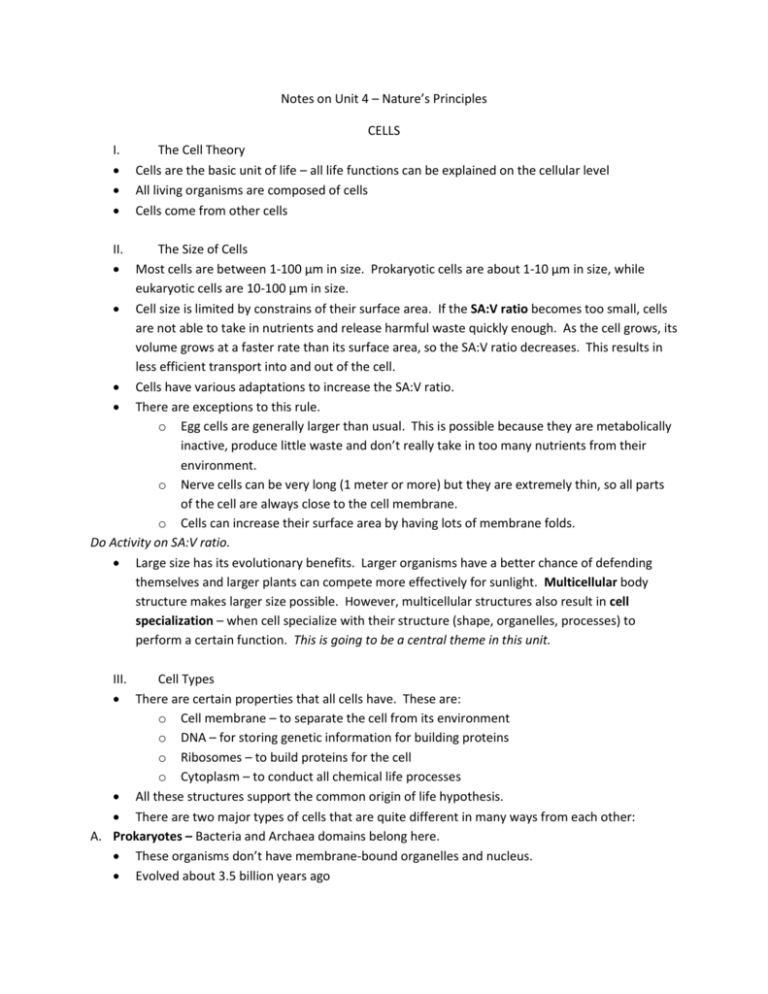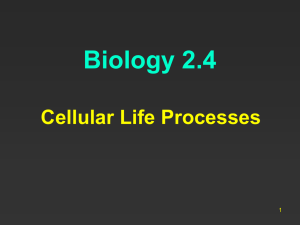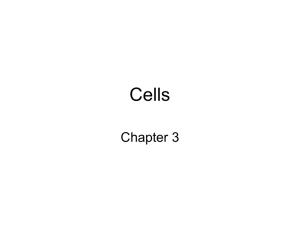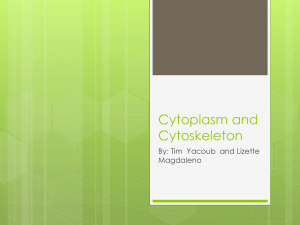Notes on Unit 4 – Nature`s Principles CELLS The Cell Theory Cells
advertisement

Notes on Unit 4 – Nature’s Principles CELLS I. The Cell Theory Cells are the basic unit of life – all life functions can be explained on the cellular level All living organisms are composed of cells Cells come from other cells II. The Size of Cells Most cells are between 1-100 µm in size. Prokaryotic cells are about 1-10 µm in size, while eukaryotic cells are 10-100 µm in size. Cell size is limited by constrains of their surface area. If the SA:V ratio becomes too small, cells are not able to take in nutrients and release harmful waste quickly enough. As the cell grows, its volume grows at a faster rate than its surface area, so the SA:V ratio decreases. This results in less efficient transport into and out of the cell. Cells have various adaptations to increase the SA:V ratio. There are exceptions to this rule. o Egg cells are generally larger than usual. This is possible because they are metabolically inactive, produce little waste and don’t really take in too many nutrients from their environment. o Nerve cells can be very long (1 meter or more) but they are extremely thin, so all parts of the cell are always close to the cell membrane. o Cells can increase their surface area by having lots of membrane folds. Do Activity on SA:V ratio. Large size has its evolutionary benefits. Larger organisms have a better chance of defending themselves and larger plants can compete more effectively for sunlight. Multicellular body structure makes larger size possible. However, multicellular structures also result in cell specialization – when cell specialize with their structure (shape, organelles, processes) to perform a certain function. This is going to be a central theme in this unit. III. Cell Types There are certain properties that all cells have. These are: o Cell membrane – to separate the cell from its environment o DNA – for storing genetic information for building proteins o Ribosomes – to build proteins for the cell o Cytoplasm – to conduct all chemical life processes All these structures support the common origin of life hypothesis. There are two major types of cells that are quite different in many ways from each other: A. Prokaryotes – Bacteria and Archaea domains belong here. These organisms don’t have membrane-bound organelles and nucleus. Evolved about 3.5 billion years ago They are about 1-10 µm sized Most of the life processes of these cells are carried out either in the cytoplasm or in folds of the cell membrane, because they are lacking organelles. They are usually single-celled, however, can form biofilms, thin layers of millions of cells of different species that help each other with various functions. Be able to draw and label the parts of these cells. The following structures are found in prokaryotes: o Nucleoid region – holds the circular shaped single bacterial chromosome (DNA) without a nuclear envelope o Plasmid – small, circular pieces of DNA, substantially smaller than the chromosome, which can be passed on from one organism to another – horizontal gene transfer. They usually contain only a few genes that are not vital but beneficial for the bacterium, such as genes for antibiotic resistance. o Pilus – short extensions of the cell membrane that help with conjugation – passing on genes from one bacterium to another. o Ribosomes – assemble the primary structure of proteins o Cell wall – made up of peptidoglycan in bacteria, but made up of different materials in Archaea. The cell wall helps with keeping the cell’s shape and protection o Glycocalyx – an outer capsule that is mostly carbohydrate based for extra protection. o Fimbriae – also called pili, but these make bacteria stick on surfaces o Flagella – long projections that make the bacterial cells able to move in water B. Eukaryotic Cells First eukaryotes appeared 2.1 billion years ago. They have membrane-bound organelles including a nucleus. The evolution of these is explained partially by the endosymbiotic theory Their size range is about 10-100 µm. Because of the compartments that the organelles create, the larger size is possible for these cells. The compartments make the cell processes more efficient. The organisms with eukaryotic cells include Protists, Fungi, Plants and Animals. These organisms can be single-celled but for the most part they are multicellular and could reach very large sizes. C. The Endosymbiotic Theory They have membrane-bound organelles. The evolution of these is explained partially by the endosymbiotic theory The Endosymbiotic Theory – Mitochondria and chloroplasts evolved from free living bacteria, when they were engulfed by simple but larger cells. Evidence: 1. These organelles have circular DNA 2. They reproduce by binary fission like bacteria do 3. Some of their metabolic enzymes are similar to bacterial enzymes 4. They are about the same size as bacteria 5. They have double membranes, one of which was the original bacterial membrane, the other was the host’s cell membrane EUKARYOTIC CELLS I. Evolution These cells evolved 2.1 billion years ago as a result of nutrient shortage pressures. These cells are more efficient at using available sources because of the compartmentalization of their life processes. These organelles (the compartments) restrict chemical reactions to certain areas and with that more complex reactions can go on in each organelle, where the required enzymes are concentrated. The more complex organization also requires more chromosomes – chromosomal structure changed to linear chromosomes and there are multiple of them in each eukaryotic cell. II. The Role of the Nucleus It is a control center of the cell, which is processing inputs from the cytoplasm, stores genetic information and carries out instructions to regulate cell functions. The instructions are coded in DNA. The instructions include genes for making proteins, making RNA and to perform reproduction. Parts of the nucleus: o Nuclear envelope – made up of TWO phospholipid bilayer with nuclear pores. These pores are large enough to transport RNA or proteins in and out of the nucleus. o Nucleolus – synthesizes rRNA to assemble the large and small subunits of the ribosomes. These subunits only combine later in the cytoplasm. o DNA – always remains in the confined and protected area of the nucleus Ribosomes are used to synthesize proteins. If the ribosomes are free floating in the cytoplasm, they synthesize proteins for the cell. If they are suspended on the rough ER, they form proteins that exit the cell. III. The Endomembrane System A set of organelles, which are functionally interrelated and located in the cytoplasm. Includes the nuclear envelope, rough and smooth endoplasmic reticulum, Golgi apparatus, cell membrane and other organelles that form from these listed ones (vesicles, vacuoles). All other organelles are listed in your book and you can take notes on them on your review sheets. http://www.youtube.com/watch?v=TYxDoP9ABHc – Harvard cell animation CYTOSKELETON I. Structure of Cytoskeletal Proteins There is a network of fibers within the cell that is only visible with very high power electron microscopes. This network collectively is called the cytoskeleton. This network organizes cellular components and cellular activities. They support and preserve the shape of the cell. They participate in moving the cell organelles, substances in or on the cell and the entire cell. The network is composed of three different fibers: o Microtubules o Microfilaments o Intermediate filaments This system is very dynamic, easily reorganizes and breaks apart. The fibers of the cytoskeleton are made up of proteins. II. Microfilaments The thinnest cytoskeletal structures, that help to support the cell membrane from the inside, compose microvilli in the small intestinal cells, they form muscle fibers They are made up of a protein called actin which forms two chains that twist together. In muscle fibers, actin is joined by an other protein called myosin. Myosin slides along the actin filaments to generate muscle contraction. Amoeba uses actin filaments to form pseudopods for motion -http://www.youtube.com/watch?v=PsYpngBG394 http://www.youtube.com/watch?v=pvOz4V699gk Actin filaments also produce cytoplasmic streaming that moves the cytoplasm of the cell around. http://www.youtube.com/watch?v=pFsty-XyLZc III. Intermediate Filaments Medium width fibers which are made up of several different types of proteins. They generally form permanent structures, because they are not as dynamic as the other two types. They form the surface structures of skin cells that they retain even after their death. These keratin layers protect underlying tissue. They can also support and anchor various organelles in position. IV. Microtubules They are hollow tubes that are made up of a protein called tubulin. These units come as dimers (alpha and beta tubulins). Microtubules form tracks within the cell for vesicles to move on, they form cilia and flagella with a 9+2 microtubule arrangement. They also form centrioles with a 9+0 arrangement of microtubules. Microtubules use ATP to bend protein arms that connect them to each other. The bending of these protein arms results in an undulating motion. http://programs.northlandcollege.edu/biology/Biology1111/animations/flagellum.html V. Cilia and Flagella They are strictly speaking not organelles, because they are outside of the cytoplasm. However, they are made up of microtubules, so they are part of the cytoskeleton. Cilia are short, many structures outside of the cell. They are made up of the 9+2 microtubule structures Flagella are long, few structures that have the same arrangement. They are both used to move the cell along. Prokaryotic cells have a different type of flagella arrangement. EXTRACELLULAR STRUCTURES I. Extracellular Structures of Plant and Animal cells Beyond the cell membrane there is a wide range of structures that can cover the cell’s surface. In plants the cell wall is the most significant, while in animal cells there is an extracellular matrix (ECM). The basic composition of these structures is similar in plant and animal cells. They both have fibrous components imbedded in a gel-like substance: o In plants cellulose fibers are imbedded in a substance of polysaccharides and proteins o In animals collagen protein fibers are imbedded into a matrix of carbohydrate molecules. These structures help with cell identification, cell attachment and anchoring (cells cannot divide unless they are attached to a solid surface), they also connect cells to other cells for transport purposes and for cell communication. II. Animal Cell Junctions Cell junctions – direct connections of cells to each other. Types of cell junctions in animal cells: o Tight junctions – connections between cells that are made by adhesive connections of the cytoskeleton. This usually protects materials from moving from cell to cell o Desmosomes – Formed by intermediate filaments, which permanently attach cells to each other and form functional units like muscle fibers. o Gap junctions – passageways between cells that allow the transport of certain substances like sugars, amino acids, ions to pass from one cell to the next. III. Plant Cell Walls Cellulose fibers are formed from β-glucose monomers. These fibers bind to each other by Hbonding and various proteins and carbohydrates are deposited in between them to form a gellike matrix. The young plant cell only produces a primary cell wall – thin, flexible wall that is able to expand and grow with the cell. As the plant cell matures, it forms a secondary cell wall – forms between the cell membrane and the primary cell wall, more rigid and does not grow any more. Plant cells use plasmodesmata for communication. These are holes on the cell wall that allow the cytoplasm of one cell to flow into the next cell and are surrounded by a cell membrane. These cytoplasmic bridges unify an entire plant. Essential materials, such as water, nutrients, and minerals can pass through the plasmodesmata. PROKARYOTES I. Prokaryotic Diversity Don’t forget to be able to draw and label the parts of a prokaryotic cell Prokaryotes are single-celled organisms with a wide range of metabolic properties. The diversity of prokaryotes relates to their ability to perform horizontal gene transfer – a gene or part of a gene moves from one organism to another. Types of horizontal gene transfer: o Transformation – uptake of foreign DNA from the surroundings. In this case, live bacteria can take in pieces of DNA from a decomposing, dead bacterium. o Transduction – prokaryotic genes are carried from a donor bacterium to a recipient bacterium by using a virus (bacteriophage) o See next page Conjugation – DNA transfer from a donor to a recipient bacterium by using two cells that connect through a sex pilus. Once the gene is incorporated by any of the methods, it remains in the genome of the recipient and is then transferred during reproduction. Because of the horizontal gene transfer, it is very hard to set up evolutionary relationships among bacteria. As a result, today, metagenomics is used to identify groups of bacteria that tend to live together in the same area. They are genetically related even if they have a more distant ancestry.









